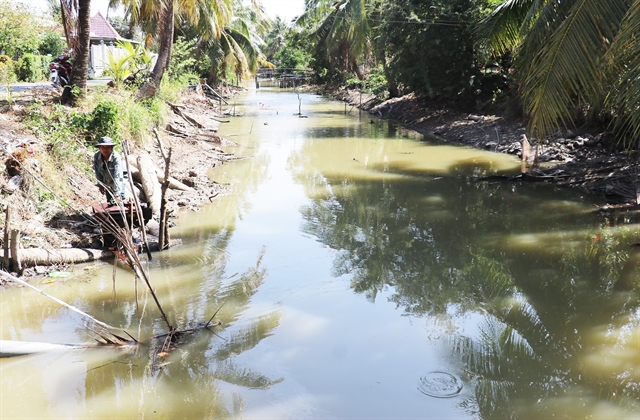 Opinion
Opinion

 |
| In light of the challenging circumstances of drought and saline intrusion, residents of southern Tiền Giang Province are adopting diverse strategies to secure water resources for irrigation, bolstering agricultural production, and safeguarding fruit orchards. — VNA/VNS Photo |
According to forecasts from specialised agencies within the Ministry of Natural Resources and Environment and the Ministry of Agriculture and Rural Development, the Mekong Delta region is facing the peak of the dry season, with severe saltwater intrusion spanning a vast area.
Hoàng Văn Đại, deputy director of the National Meteorological and Hydrological Forecasting Centre (under the General Department of Meteorology and Hydrology, Ministry of Natural Resources and Environment), talked to the press, urging local authorities and residents of provinces in the Mekong Delta region to diligently monitor forecasts of saltwater intrusion.
Could you please provide an update on the current situation regarding drought and saltwater intrusion in the Mekong Delta region?
Since the beginning of the 2023-24 dry season, the Mekong Delta has experienced three significant periods of saltwater intrusion. Based on our salinity monitoring, this year's saltwater intrusion is higher than the multi-year average and surpasses that of 2023.
The most severe intrusion occurred from March 8-13, with a high salinity level of four parts per thousand (the measure of the number of grams of salts per kilogram of seawater) reaching depths of 40-66 kilometres inland, with some areas experiencing even deeper penetration. Salinity levels of one part per thousand were recorded in Tiền Giang and Bến Tre provinces, extending to depths of approximately 70-76 kilometres, varying depending on the river.
According to the national meteorological and hydrological agency, dangerous weather phenomena such as thunderstorms, tornadoes, lightning and hail are expected to persist throughout April 2024, potentially impacting livelihoods.
Particularly in Bến Tre Province, saltwater intrusion is equivalent to that of 2016, with the Cổ Chiên River experiencing even deeper intrusion compared to 2016. Additionally, canals and streams in some provinces are facing drought conditions, leading to land subsidence in several provinces south of the Hậu River.
This situation may pose challenges to rice production, as provinces in the Mekong Delta region are concluding harvesting by the end of March and will soon commence sowing for the 2024 Autumn-Winter rice crop.
What are the causes of the drought and saltwater intrusion in the Mekong Delta during the 2023-24 dry season?
The situation can primarily be attributed to the influence of El Nino, which has resulted in minimal rainfall, ranging from 60-95 per cent below normal, in the Mekong Delta since the beginning of 2024. Prolonged periods of sunshine have led to significant evaporation of surface water in fields, canals, rivers and lakes. Additionally, the water levels in the upper Mekong River have been lower than the multi-year average, exacerbating the situation, coupled with tidal peaks pushing saltwater further inland.
According to forecasts from the National Meteorological and Hydrological Forecasting Centre, prolonged heatwaves are expected in the southern region due to the delayed onset of the rainy season. How many more saltwater intrusion events are predicted until the end of the 2024 dry season?
The rainy season in the south is anticipated to arrive later than usual, around mid-May. Consequently, intense heatwaves will persist in this region with high temperatures.
Until the end of the 2024 dry season, the flow from the upper Mekong River to the Mekong Delta is projected to remain below the multi-year average. Approximately three more significant saltwater intrusion events are predicted, occurring from April 8-14, April 23-28 and May 6-12.
The peak intrusion is anticipated from April 8-14, with salinity levels reaching 4g/l at river mouths, surpassing the multi-year average and exceeding 2023 levels.
Salinity intrusion on the Vàm Cỏ River is expected to extend inland by 80-100km; the Cửu Long River mouths will experience intrusion depths of 48-70km; and the Cái Lớn River will be impacted within a range of 50-57km. This intrusion will significantly affect livelihoods and agricultural production in the region, particularly in provinces such as Tiền Giang, Bến Tre, Hậu Giang, Trà Vinh, Sóc Trăng and Cà Mau.
Continued monitoring and forecasting are crucial to developing coordinated solutions addressing the drought and saltwater intrusion in the Mekong Delta. This proactive approach enables provinces and municipalities to plan effectively for production, economic development and social welfare throughout the region.
Saltwater intrusion threatens agricultural production and livelihoods in the Mekong Delta region. Continued monitoring and planning are crucial for effective mitigation. — VNS




